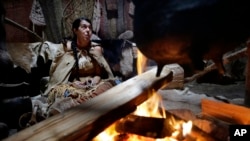ທຸກໆປີໃນວັນພະຫັດຂອງອາທິດທີສີ່ໃນເດືອນພະຈິກ, ປະຊາຊົນອາເມຣິກັນຈະສະເຫຼີມສະຫຼອງວັນຂອບຄຸນພະເຈົ້າ ຫຼື Thanksgiving. ມັນເປັນການລະນຶກເຖິງງານລ້ຽງ ການເກັບກ່ຽວໃນປີ 1621 ເວລາທີ່ນັກອານານິຄົມ, ຜູ້ທີ່ໄດ້ມາຈາກປະເທດ ອັງກິດ, ໄດ້ແລກປ່ຽນອາຫານມິດຕະພາບກັບຄົນພື້ນເມືອງຂອງດິນແດນ.
ໃນເມືອງ ພລາຍມັດ, ລັດ ແມສຊາຈູເຊັດສ໌, ເຊິ່ງເປັນສະຖານທີ່ ຂອງວັນ Thanksgiving ແຫ່ງທຳອິດນັ້ນ, ບັນດານັກປະຫວັດສາດ ແລະ ຄົນອື່ນໆໄດ້ພະຍາຍາມທີ່ຈະແຍກຂໍ້ເທັດຈິງຈາກນິທານ ກ່ຽວກັບ ຄຳອະທິບາຍທີ່ໄດ້ມີອອກມາວ່າ ການສະເຫຼີມສະຫຼອງງານລ້ຽງຄັ້ງທຳອິດນັ້ນໄດ້ເກີດຂຶ້ນດົນກວ່າ 400 ປີທີ່ຜ່ານມາ.
ທ່ານນາງ ພອລລາ ປີເຕີສ໌, ເຊິ່ງແມ່ນເປັນຊົນເຜົ່າ ແມສປີ ແວມພານວກ (Mashpee Wampanoag) ຜູ້ທີ່ເຊື່ອວ່າບັນພະບຸລຸດຂອງລາວໄດ້ເຂົ້າຮ່ວມງານລ້ຽງ Thanksgiving ຄັ້ງທຳອິດນັ້ນກ່າວວ່າ “ບັນຫາ ກ່ຽວກັບ ມັນກໍແມ່ນວ່າມັນມີຄວາມຄິດຕາຍຕົວຈຳນວນຫຼາຍ ແລະ ຂໍ້ມູນທີ່ຜິດຢ່າງຫຼວງຫຼາຍທີ່ມີຂຶ້ນ ກ່ຽວກັບ ເລື່ອງນັ້ນ. ມັນເປັນເລື່ອງທີ່ເຮັດໃຫ້ປະຫວັດສາດຂອງຊົນເຜົ່າ ແວມພານວກ ບໍ່ໄດ້ຮັບຄວາມສຳຄັນແທ້ໆ.”
ບັນດານັກສະແຫວງບຸນໄດ້ເດີນທາງໂດຍເຮືອ ເມຟລາວເວີ (Mayflower) ມາເຖິງໃນປີ 1620. ຮອດລະດູໜາວ ໃນປີທີສອງຂອງເຂົາເຈົ້າ, ເຂົາເຈົ້າໄດ້ມີຄວາມດີ້ນຮົນ, ຈົນກວ່າຄົນພື້ນເມືອງໄດ້ສອນເຂົາເຈົ້າວິທີປູກພືດ ແລະ ຫາອາຫານດ້ວຍການເຮັດນາ, ລ່າສັດ ແລະ ອື່ນໆ.
ນາງ ມາລິສຊາ ຄອສຕ້າ, ສະມາຊິກຊົນເຜົ່າ ແວມພານວກ, ຜູ້ທີ່ຄວບຄຸມງານວາງສະແດງ ທີ່ມີຫົວຂໍ້ວ່າ ຊົນເຜົ່າພື້ນເມືອງອາເມຣິກັນ ຢູ່ຫໍພິພິທະພັນ ພລາຍມອດ ພາທູເຊັດ (Plimoth Patuxet) ໄດ້ກ່າວວ່າ “ເວລາທີ່ພວກເຮົາຄິດ ກ່ຽວກັບ ບັນດານັກສະແຫວງບຸນທີ່ໄດ້ເດີນທາງມາ, ພວກເຮົາລືມ ກ່ຽວກັບ ແງ່ມຸມທີ່ປະຊາຊົນ ແວມພານວກ ໄດ້ຊ່ວຍເຫຼືອເຂົາເຈົ້າໃຫ້ເອົາຊີວິດລອດໃນລະດູໜາວ, ຫຼື ແມ່ນກະທັ້ງເດີນທາງໄປມາ ໃນດິນແດນນີ້, ຫຼື ເດີນທາງຢູ່ນ້ຳ, ເຊິ່ງແມ່ນສຳຄັນຫຼາຍ.”
Every year, on the fourth Thursday in November, Americans celebrate Thanksgiving. It's a commemoration of the 1621 harvest feast when the colonists, who came from England, shared a friendly meal with the land's Indigenous people.
In Plymouth, Massachusetts, site of the first Thanksgiving, historians and others try to separate fact from fiction surrounding the legend that grew out of that initial celebratory feast that took place more than 400 years ago.
"The problem with it is that there are so many stereotypes and so much misinformation that's bundled into that story," says Paula Peters, a citizen of the Mashpee Wampanoag Tribe whose ancestors are believed to have been at the first Thanksgiving. "It's a story that really marginalizes the Wampanoag history."
First Thanksgiving
The pilgrims arrived on the Mayflower in 1620. By their second winter, they were struggling, until the Indigenous people taught them how to plant crops and live off the land.
"When we think about the pilgrims coming over, we forget about the aspect of the Wampanoag people helping them survive that winter, or even navigate this land, or navigate the waters, which is very important," says Wampanoag Tribe member Malissa Costa, who oversees the Native American-themed exhibit at the Plimoth Patuxet Museums.





